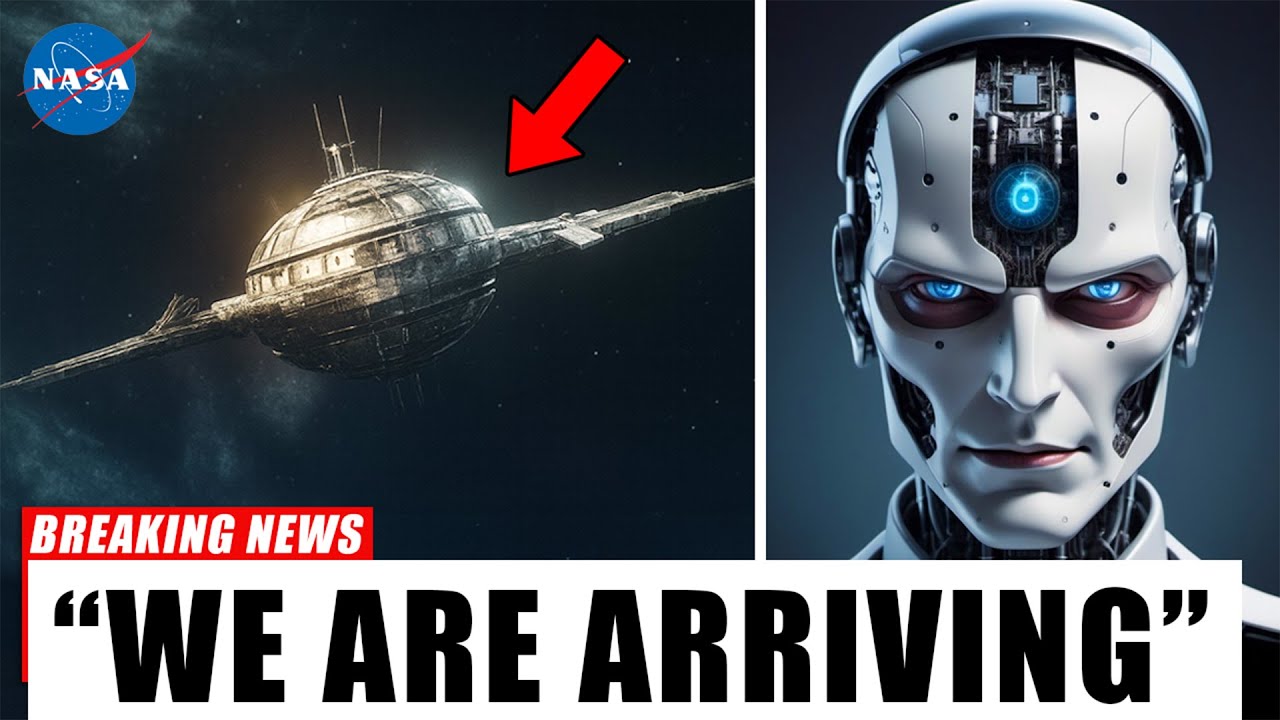🚨 NASA’s decoding it NOW: A chilling “final transmission” from 3I/ATLAS just pierced Earth’s atmosphere—whispers of ancient warnings, lost civilizations, or something far worse… 📡😨
Strange pulses, encoded signals defying physics, and a glow that’s no comet tail. Is this ET’s goodbye… or a wake-up call humanity can’t ignore? The world’s on edge as experts race to translate before it vanishes.
What hidden message would break you? Unravel the signal:

The internet is ablaze with claims of a “final transmission” from the interstellar comet 3I/ATLAS, with viral videos and social media posts suggesting NASA has intercepted an encoded alien signal that could upend life on Earth. Titles like “3I/ATLAS Final Transmission CONFIRMED — The World Is Not Ready!” have racked up millions of views, portraying the object as a beacon broadcasting dire warnings from a distant civilization. Yet, in a familiar echo of past cosmic scares, NASA and astronomers worldwide have dismissed the notion outright, confirming that 3I/ATLAS emits no such signals—only the natural radio noise and gas emissions typical of a comet. The hoax, blending real scientific observations with fabricated “leaks,” underscores the growing challenge of misinformation as this rare visitor hurtles toward our inner solar system.
Discovered on July 1, 2025, by the NASA-funded Asteroid Terrestrial-impact Last Alert System (ATLAS) telescope in Chile’s Río Hurtado observatory, 3I/ATLAS is the third confirmed interstellar object to grace our cosmic neighborhood, following the cigar-shaped ‘Oumuamua in 2017 and Comet 2I/Borisov in 2019. Clocking speeds of about 130,000 miles per hour, it originates from the direction of the constellation Lyra and traces a hyperbolic trajectory unbound to our Sun, destined to exit the solar system after a fleeting tour. Its path includes a close shave with Mars on October 3 at roughly 28 million kilometers, perihelion—its solar closest approach—on October 29-30 at 1.36 AU (about 203 million kilometers, inside Mars’ orbit), and a Venus flyby in early November before a distant Jupiter rendezvous in March 2026. For Earth, the nearest pass comes December 19 at 1.8 AU (270 million kilometers), far enough to eliminate any impact fears, as reiterated by NASA’s Planetary Defense Coordination Office.
Early Hubble Space Telescope snaps from July 21 painted a picture of a modest nucleus, spanning 3.5 to 5.6 kilometers, wrapped in a reddish dust haze but showing scant tail activity—prompting initial debates on whether it was a rocky asteroid or icy interloper. By late August, Gemini South telescope imagery and shots from astrophotographers revealed a burgeoning blue-green coma and a stretching tail, hallmarks of solar heat vaporizing embedded ices into gas and dust. Spectroscopic dives by the James Webb Space Telescope (JWST) on August 6 and the Very Large Telescope (VLT) uncovered a peculiar makeup: an 8:1 carbon dioxide-to-water ice ratio—the highest recorded—laced with cyanide gas, atomic nickel vapor, and organic tholins, those reddish carbon chains forged by eons of interstellar radiation. This dry, CO2-heavy profile hints at origins in a far-flung stellar nursery, potentially the Milky Way’s thick disk, making 3I/ATLAS at least 7 billion years old—older than our own solar system by a billion years.
Pre-discovery glimpses from ATLAS and NASA’s Transiting Exoplanet Survey Satellite (TESS) dating back to June 5 extend its known path, explaining why it evaded detection earlier: It crossed the crowded Galactic Center’s star fields, where its faint glow blended into the stellar soup. Amateur astronomer Sam Deen flagged these observations, noting the comet’s marginal coma emerged around July 2, confirmed by telescopes in Chile, Arizona, and Hawaii. The Minor Planet Center dubbed it C/2025 N1 (ATLAS) for its cometary traits, but its interstellar speed and unbound orbit earned the “3I” tag—the third such wanderer.
The “final transmission” myth exploded mid-September, twisting these facts into extraterrestrial fiction. A YouTube video uploaded September 20 by Cosmic Echoes, titled “3I/ATLAS Final Transmission CONFIRMED — The World Is Not Ready!”, alleges NASA intercepted modulated radio bursts from the comet, decoding them as warnings of impending cosmic catastrophe or a “beacon from extinct worlds.” Clocking over 300,000 views in days, it cites “leaked SETI data” showing pulsed emissions at 1420 MHz—the hydrogen line frequency often eyed for alien chatter—synced to the comet’s spin. Another clip from Stellar Whispers on September 22 claims the tail’s green glow hides encrypted light patterns, visible only in ultraviolet, hinting at a “dying probe’s last cry.” These videos mash Hubble footage with dramatic soundtracks and bogus spectrographs, warning viewers to “prepare for disclosure” as the comet nears the Sun.
Social media poured gasoline on the fire. On X, user @PaulsMarketingV posted September 23: “3I ATLAS Odds Increase To Almost 50% Of Being Alien,” linking the YouTube hoax and racking up hundreds of shares. @JENSOLEHIERON echoed with “3I/ATLAS’s Final Signal JUST WARNED THE WORLD,” tying it to doomsday prophecies. @FemaZone6 shared an update: “The Closer 3I/ATLAS Is Getting to Mars, The More Alien It Looks,” blending real Gemini images with alien overlays. Threads from @UAPWatchers and @Earthfiles speculated on “quantum signals” reacting to human observation, invoking wave-function collapse and suggesting the comet “knows we’re watching.” One post from @mojustinX posed: “Rock or Messenger? 3I/ATLAS could rewrite everything,” polling followers on comet vs. signal, with replies flooding in theories of “Dark Forest” probes or ancient AI. Engagement soared—@AntiWokeMemes quipped about it arriving for Thanksgiving, joking it’d “scare off the turkey”—while @RisksAndVirtues asked Grok for trajectory studies, only to get a grounded debunk.
Harvard’s Avi Loeb, no stranger to interstellar intrigue, inadvertently fed the frenzy. His July arXiv paper with Adam Hibberd and Adam Crowl crunched the comet’s “improbable” path: a near-ecliptic tilt allowing those planetary flybys, with odds under 0.005%. Loeb’s August Medium essay floated a nuclear-powered craft hypothesis to explain the early gigawatt luminosity and CO2 dominance—suggesting internal heat, not just solar, mimicking a comet’s outgassing. He pegged artificial odds at 40-50% in a September NewsNation spot, urging intercepts via SpaceX Starship or NASA’s Juno. A fringe piece from Union Rayo on September 19 claimed “20 scientists confirm” it’s a camouflaged spacecraft, citing Loeb’s work but twisting it into consensus. Loeb clarified in a Planetary Society interview: “It’s pedagogical speculation—data screams comet, but anomalies warrant vigilance.”
NASA’s rebuttal was swift and science-backed. A September 23 update stated: “3I/ATLAS shows no artificial signals; detected emissions are thermal radio from heated dust and neutral gases like CO and CN, standard for comets.” The agency’s Deep Space Network and the Allen Telescope Array scanned for anomalies around the hydrogen line but found only broadband noise, no modulation. JWST’s near-infrared spectra from August ruled out laser-like pulses, attributing the green hue to organic fluorescence, not encoded light. VLT data on September 18 confirmed cyanide and nickel at solar-system norms, with the tail’s 2.5-arcminute span pure outgassing—no directional thrust or comms.
Skeptics like Northeastern’s Jacqueline McCleary, who dissected 3I/ATLAS in a September 9 explainer, called the transmission talk “recycled ‘Oumuamua hype.” She noted the CO2 ratio offers a snapshot of alien planetary formation—dry ices suggesting a cooler birth star—but nothing technological. Bryce Bolin, lead on a September Astrophysical Journal Letters study and veteran of all three interlopers, told Planetary Radio: “Pre-discovery TESS frames show steady coma growth; if it were signaling, we’d see Doppler shifts or polarization oddities. It’s a natural relic, not a radio.”
Global missions are locked in for verification. ESA’s Mars Express and ExoMars Trace Gas Orbiter gear up for the October 3 Mars flyby, deploying spectrometers to sniff the coma for exotic isotopes. NASA’s Juno and ESA’s Juice may snag tail samples at Jupiter, while SOHO and STEREO-A monitor perihelion for fragmentation. Psyche and Lucy could opportunistically glance during their asteroid hops, and SPHEREx’s ice maps from August provide baselines. Ground arrays like the Vera C. Rubin Observatory, prepping for 2026, will track its December reemergence, when the tail might blaze naked-eye bright.
The hoax mirrors 2017’s ‘Oumuamua light-sail buzz and Hale-Bopp’s 1997 apocalypse ties, amplified by AI-generated “leaks.” BBC Sky at Night’s September 18 feature labeled it “interstellar overhype,” praising the comet’s once-in-a-lifetime views but debunking signals. The Guardian’s September 20 op-ed, “Comets Aren’t Calling,” warned of pseudoscience eroding trust in real threats like solar flares. IFLScience fact-checked the videos September 21, tracing “transmission” claims to misread radio astronomy data—natural synchrotron from charged particles, not ET Morse code.
As 3I/ATLAS dims from September views, fading behind the Sun until early December, its passage stirs genuine awe: A 7-billion-year-old envoy from the galaxy’s depths, whispering of other worlds through its ices. Loeb’s Galileo Project pushes for protocols on future visitors—perhaps a UN interstellar task force—but for now, no transmissions, just science. NASA’s Thomas Statler summed it in a Debrief chat: “We’re thrilled for the data, not terrified by fiction. 3I/ATLAS is a comet—study it, don’t sensationalize it.” In the silence of space, the real message? Curiosity, not conspiracy, lights the way.





